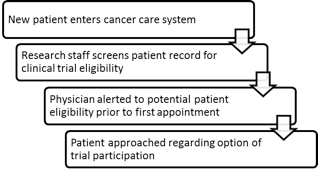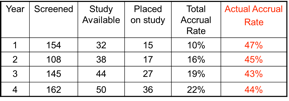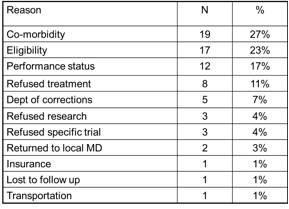Making a Difference in Clinical Trials Accrual: The Integration of Prescreening All Patients for Eligibility
Applied Clinical Trials
Physician participation in and patient access to cancer treatment clinical trials (CCTs) are key measures for delivery of quality cancer care.
Editor's Note: A version of this article appeared in print.

Introduction
Physician participation in and patient access to cancer treatment clinical trials are key measures for delivery of quality cancer care.1,2 A recent Institute of Medicine (IOM) committee stated that the “therapies offered through cancer clinical trials should ideally be considered the preferred treatment choice for physicians and patients, if they are available” and recommended that that all oncologists “strive to make participation in clinical trials a key component of clinical practice and to achieve… high accrual rates of 10% or more.”3 Despite these guidelines, current adult trial participation in the United States remains under 3 percent.4,5,6 Participation is even lower among patients who are from racial or ethnic minority groups, are age 65 or older, and/or live in rural areas.7,8,9,10,11,12,13 A number of studies have shown that cancer health disparities are due in large part to receipt of less-than-standard care;3,8,10,11,12,14 according to the IOM, increasing clinical trial participation among minority populations can address these persistent disparities.15
Although numerous challenges face the cancer clinical research system,3 most studies have focused on individual barriers to clinical trial participation, specifically barriers related to a lack of knowledge and underlying attitudes and beliefs among patients.14,15,16 What is often overlooked are accrual barriers related to ineffective operational procedures, such as inconsistent screening and approach.18,19
Studies have found that only between 9% and 20% of cancer patients are informed about the option of participating in an oncology trial.14,15,16,17,18,19,20,21,22 Even at major cancer centers, oncologists may not approach all eligible patients about participation23, and patients from minority groups or who are age 65 or older are less likely to be approached, regardless of eligibility.11,24,25,26,27
While accrual is a critical outcome, the metric of “pre-screening,” defined as basic patient matching to cancer clinical trial requirements based at the very least on age, sex, cancer location, and stage can systematically flag patients for additional screening and/or make consistent offers for participation. Such systematic patient screening has been shown to increase clinical trials enrollment, and reduces the opportunity for bias.28,29 Institutions conducting cancer clinical trial can improve accrual by adopting procedures to help ensure that 100% of patients are screened for trial eligibility prior to treatment discussion, and that ultimately, 100% of eligible patients are approached about participation.30
Figure 1 illustrates a prototypical example of the pre-screening process, even though pre-screening may look different for every institution. In fact, many sites may experience additional challenges due to HIPAA or the local institutional review board (IRB). While HIPAA protects patients' protected information, most IRBs and privacy officers allow screening of medical records for the purpose of identifying patients that may benefit from participation in a clinical trial. The results of the screening are given to the treating physician, who then discusses the trial with the patient. While clinical trial teams may flag charts of the patients scheduled to be seen that day, it has been documented that at least 30% of accrual sites, if not more, have no systematic approach to screening patient charts for patient eligibility.31
Figure 1- Pre-Screening Process

This article will describe the experience of two cancer clinical trial sites and a national multi-site collaborative project--each of which addressed improvements in pre-screening to enhance accrual.
Meharry Medical College Clinical Trials Office
Located in Nashville, Tenn., Meharry Medical College (MMC) incorporated Nashville General Hospital from its original downtown location onto its campus in 1998 to facilitate continuation of the city hospital. Two years later, the research team formed at MMC under an NCI U54 Partnership grant allowing for implementation of clinical trials operations at the site. Finally, in 2003, MMC was awarded a Minority Based Community Clinical Oncology Program (MBCCOP) grant. The site serves a significant African-American population in North Nashville and the institution predominantly serves medically underserved patients.
The clinical trial team at MMC began by exploring some of the barriers faced by the patient population as it related to cancer care as well as clinical trial participation. Some of the major observations from this assessment included things such as frequency of missed appointments/poor follow-up, missed communication (i.e., how physicians and patients learned of the pathology results), missed rides and transportation, lack of insurance, and the need for ensuring patient comprehension about cancer and their care.
Early on, the research team recognized the need to identify every patient that was entering its system. This was challenging considering the various entry points for patients throughout the healthcare system. The clinical trials office (CTO) established a protocol to have all pathology reports sent to the office in order to track each diagnosis of cancer and to let the ordering physician know when a report indicates cancer. In addition, the cancer committee requested that every patient coming through the system would be screened for a cancer clinical trial as standard policy. Screening involves not only matching for disease type and stage but whether the trial is applicable for the particular patient. The information is entered into a database for review at weekly research team meetings. Team members review progress through the system and arrange appointments and referrals as needed for diagnostic workup and staging. The patient is navigated through the system using a nurse navigator and a research nurse.
Physicians are advised if a clinical trial is available and informed of plans developed by CTO to address obstacles such as transportation for related medical visits or medications; this is seen as an important way to further support physicians in their ability to offer a trial to the patient during initial treatment discussion. CTO staff monitor whether the patient is ultimately placed onto a study. The option of clinical trial participation is offered during initial treatment discussion. Patients can receive clinical trial care in their usual care facility and it is not offered as another option after the treatment discussion has occurred.
Results of the Program
As published in detail in the literature elsewhere32 and briefly summarized below, using this approach, in a four-year period, MMC went from a 10% accrual rate to 22% (see Table 1 below). The overall accrual rate is calculated by number of patients on a study divided by number of new patients in the clinic (154/15=10%). When evaluated in the context of patients for whom there were studies available for their disease and stage and were offered trials (32), the actual accrual rate (15) for patients who enrolled was even higher (32/15=47%), demonstrating that minority patients would be just as willing to participate in cancer clinical trials when presented as a quality care option.
The most common reason (67%) patients did not join a study had to do with physical status, such as the presence of co-morbidities, laboratory abnormalities, and performance status; less than 10% refused participation on a particular study, (see Table 2).
Table 1-Clinical Trial Accrual Rates

Table 2-Reasons for Non-Enrollment

Over a seven-year period, MMC has sustained its 21% overall accrual rate and actual accrual rate (patients with a study available) at over 65%. Accrual was particularly successful in cancer control and prevention trials, with solid improvement in the accrual rate among treatment trials as well. The proportion of patients enrolled to studies also reflected the overall demographics of patients seen at MMC.
The Meharry experience strongly suggests that racial/ethnic minority and underinsured patients are willing to participate in cancer clinical trials. Ensuring success requires a team approach and case management (navigation) strategies, along with taking a proactive rather than reactive approach to address screening needs. The pre-screening process also presented an opportunity to examine the extent of patients that they did not have available studies for and to take into consideration when to modify the site’s future research portfolio to meet this need.
Vanderbilt Ingram Cancer Center Clinical Trials Shared Resource
The Vanderbilt Ingram Cancer Center (VICC) sees over 5,500 new cancer diagnoses annually. More than 600 patients participate and are active in therapeutic studies each year. VICC has more than 250 protocols available for adult patients. Its Clinical Trials Shared Resource (CTSR) is organized by disease site teams, with each team led by a physician and manager and a team of nurses, regulatory and data coordinators, and other research support staff.
Patients enter into the VICC system through a variety of methods, including direct referrals; the access center, which is a call center for appointments; external referrals; self-referrals; and the Clinical Trial Information Program (CTIP). In existence at VICC for more than 15 years, the program is staffed by registered nurses who screen for clinical trial eligibility.
In the last two years, the CTIP began to proactively screen patient records for trial eligibility. A list of new patients is generated from the electronic medical record (EMR) daily. The screener reviews this list and looks at any additional records available to assess whether there is a study for the disease site and stage and whether the patient is eligible based on known information. An email is then sent to the physician indicating that the patient may be eligible for a clinical trial or is not eligible.
A follow-up is conducted by CTIP to determine the outcome for the patient.
Results of the Program
Using one team as an example of VICC’s screening efforts (see Table 3), between December 2011 and June 2012, of the 692 cases seen, 123 were screened as eligible for trials, with 10 going on to enroll in a study. Among those patients who did not enroll, 74 did not meet the eligibility criteria, 20 declined participation, and eight were due to “physician choice.” It was particularly helpful to follow-up on the latter data group to help determine what the nature of any potential concerns were, so they could be addressed where possible.
Table 3-Study Team Example (BMT-HEM) Pre-Screening Outcomes 12/26/11-6/1/12

Among the key lessons learned to date with the VICC experience has been a greater appreciation of the varied reasons why patients do not enroll in clinical trials. While some of the barriers may be patient-related, many have to do with availability of studies that match the patient population, study design, and eligibility criteria, whether the patient was appropriately screened, and equally as important, if the patient was actually offered the option of trial participation by the physician. To that end, strategies to increase clinical trial accrual must include:
- Identifying all potential patients before treatment options have been presented
- Tracking reasons for going on or not going on clinical trials
- Matching studies to the population
- Increasing communication about available trials, optimally in the community prior to a patient’s diagnosis
- Having a plan to overcome barriers such as transportation, housing, and extra costs
Five Sites Participating in ENACCT’s National Cancer Clinical Trials Pilot Breakthrough Collaborative
Founded as a national non-profit organization in 2004, the Education Network to Advance Cancer Clinical Trials (ENACCT) focuses exclusively on identifying, implementing, and evaluating innovative community-centered approaches to cancer clinical trials education. ENACCT's National Cancer Clinical Trials Pilot Breakthrough Collaborative was the first-ever national effort to identify best practices for recruitment, accrual, and retention through a systematic, proven quality improvement process.
ENACCT selected five community oncology practices to test and implement specific changes in organizational practices. The goal was to identify practical, patient-centered approaches to significantly improve the accrual of eligible patients to cancer clinical trials, with a particular focus on patients from ethnic and racial minority groups and those age 65 and older (see descriptions of the five oncology practice teams below). Read more about the teams here: http://www.enacct.org/our-programs/national-learning-collaborative.
One of the important quality improvement measures the pilot focused on was the implementation of new pre-screening/screening processes prior to physician consultation. Measures related to prescreening included the following:
Table 4-Pre-Screening Process Measures

Results of the Program
Team A
- Developed a process for consistent screening of all new patients for clinical trial eligibility using a computer program allowing for the printing of the daily schedule, which identifies all new patients. As a quality assurance method, this list is checked again at the end of the day for no-shows and cancellations.
- Began investigating new trials that more appropriately meet their patients’ diagnoses and comorbidities.
- Increased tracking of data and statistics regarding the number of patients seen, how many were potentially eligible, and how many were approached, in order better illuminate processes and areas that may need improvement.
Team B
- Standardized communication with physicians regarding eligible patients, including asking physicians to indicate why (or why not) a patient was offered a trial.
Team C
- Implemented a rotating assignment of pre-screening patient charts to individual oncology research nurses to improve efficiency and reduce redundancy.
Team D
- Created a process that ensured screening of new patients who were initially missed by the research department when they were called and seen on the same day. Medical assistants were tasked with alerting the research department to newly added patients. A staff member from the research department would then inform the physician of pertinent open clinical trials.
Team E
- Established a quarterly competition and awarded prizes to teams with the highest total screening, enrollment, and highest increases in percent and number enrolled.
Over the ten-month period of the pilot, reported changes by the sites as a result of the collaborative included:
- Improvements in the capture of race and ethnicity data, which is providing direction for developing better referral relationships to increase patient diversity
- Improvements in processes for screening and assessing trial match to new patients and informing assessment of the viability of opening new trials
- Enhanced documentation of pre-screening and offer rates to identify system gaps and ways to increase these rates
ENACCT’s pilot collaborative showed that a proven quality improvement framework, never before applied to the cancer clinical research setting, was both feasible and able to generate meaningful improvements in organizational processes and procedures as it relates to pre-screening/screening. Given the short duration of the pilot, there was limited ability to measure changes to accrual within the timeframe. However, it is anticipated that over time, these changes will increase cancer clinical trial accrual rates, in particular among ethnic minorities and the elderly. Based on the invaluable lessons learned, ENACCT is currently developing a second-generation learning collaborative to test further changes.
Conclusions & Future Directions
This article describes three distinct experiences around the use of pre-screening to improve patient accrual rates in cancer clinical trials. These sites used a variety of approaches to accomplish this strategy and are at the forefront nationally in this effort, as very few cancer clinical trial settings across the country have a comprehensive approach to pre-screening in place. For similar results to be replicated elsewhere, there is a clear need for additional training and funding to enhance sites’ capacity for pre-screening.
While serving as a very important tool for clinical trial sites, compilation of patient-screening data alone is simply not enough. Data should be consistently compared with the rate of how many patients are actually approached about the possibility of participating in a trial and reasons why they may decline, whether physician- or patient-driven. Effective collection of these metrics over time can help determine gaps in the “leaky pipe” that impede access for patients and ultimately lead to improved rates of accrual.
Cancer treatment institutions that take decisive action to close the gaps in screening and approach can position themselves to be at the forefront of overcoming critical accrual challenges, accelerating process in cancer care for all.
References
1 National Comprehensive Cancer Network Guidelines. 2009. (Accessed at http://www.nccn.org/professionals/physician_gls/f_guidelines.asp.)
2 American College of Surgeons: Commission on Cancer. Cancer Program Standards, Revised Edition. Chicago, IL; 2009.
3 Nass SJ, Moses HL, Mendelsohn J. A National Cancer Clinical Trials System for the 21st Century: Reinvigorating the NCI Cooperative Group Program. Washington, D.C.: The National Academies Press; 2010.
4 National Cancer Institute Digest Page: Boosting Cancer Trial Participation. 2008. (Accessed at http://www.cancer.gov/clinicaltrials/conducting/boosting-trial-participation/Page3.)
5 Christian MC, Trimble EL. Increasing participation of physicians and patients from underrepresented racial and ethnic groups in National Cancer Institute-sponsored clinical trials. Cancer Epidemiol Biomarkers Prev 2003;12:277s-83s.
6 National Cancer Institute. Cancer clinical trials: A resource guide for outreach, education, and advocacy. 2006. (Accessed at http://www.cancer.gov/clinicaltrials/resources/outreach-education-advocacy.)
7 Brawley OW. The study of accrual to clinical trials: can we learn from studying who enters our studies? J Clin Oncol 2004;22:2039-40.
8 Lewis JH, Kilgore ML, Goldman DP, et al. Participation of patients 65 years of age or older in cancer clinical trials. J Clin Oncol 2003;21:1383-9.
9 Murthy VH, Krumholz HM, Gross CP. Participation in cancer clinical trials: race-, sex-, and age-based disparities. Jama 2004;291:2720-6.
10 Powe NR, Gary TL. Race and Research in Focus: Perspectives on Minority Participation in Health Studies: Clinical Trials Chapter: American Public Health Association; 2004.
11 Sateren WB, Trimble EL, Abrams J, et al. How sociodemographics, presence of oncology specialists, and hospital cancer programs affect accrual to cancer treatment trials. J Clin Oncol 2002;20:2109-17.
12 Stewart JH, Bertoni AG, Staten JL, Levine EA, Gross CP. Participation in surgical oncology clinical trials: gender-, race/ethnicity-, and age-based disparities. Ann Surg Oncol 2007;14:3328-34.
13 Al-Refaie WB, Vickers SM, Zhong W, Parsons H, Rothenberger D, Habermann EB. Cancer trials versus the real world in the United States. Ann Surg 2011;254:438-42; discussion 42-3.
14 Ford JG, Howerton MW, Bolen S, et al. Knowledge and access to information on recruitment of underrepresented populations to cancer clinical trials. Evid Rep Technol Assess (Summ) 2005:1-11.
15 Haynes MA, Smedley BD, eds. The Unequal Burden of Cancer: An Assessment of NIH Research and Programs for Ethnic Minorities and the Medically Underserved. Washington, D.C.: National Academies Press; 1999.
16 Sabesan S, Burgher B, Buettner P, et al. Attitudes, knowledge and barriers to participation in cancer clinical trials among rural and remote patients. Asia Pac J Clin Oncol 2011;7:27-33.
17 Wallington SF, Luta G, Noone AM, et al. Assessing the Awareness of and Willingness to Participate in Cancer Clinical Trials Among Immigrant Latinos. J Community Health 2011.
18 Ulrich CM, James JL, Walker EM, et al. RTOG physician and research associate attitudes, beliefs and practices regarding clinical trials: implications for improving patient recruitment. Contemp Clin Trials 2010;31:221-8.
19 Wujcik D, Wolff SN. Recruitment of African Americans to National Oncology Clinical Trials through a clinical trial shared resource. J Health Care Poor Underserved 2010;21:38-50.
20 Comis RL, Miller, J. D. Cancer clinical trials awareness and attitudes in cancer survivors. Philadelphia: Coalition of Cancer Cooperative Groups; 2005.
21 Comis RL, Miller JD, Aldige CR, Krebs L, Stoval E. Public attitudes toward participation in cancer clinical trials. J Clin Oncol 2003;21:830-5.
22 Fenton L, Rigney M, Herbst RS. Clinical trial awareness, attitudes, and participation among patients with cancer and oncologists. Community Oncology 2009;6:207-13.
23 Albrecht TL, Eggly SS, Gleason ME, et al. Influence of clinical communication on patients' decision making on participation in clinical trials. J Clin Oncol 2008;26:2666-73.
24 Ford JG, Howerton MW, Lai GY, et al. Barriers to recruiting underrepresented populations to cancer clinical trials: a systematic review. Cancer 2008;112:228-42.
25 Joseph G, Dohan D. Diversity of participants in clinical trials in an academic medical center: the role of the 'Good Study Patient?'. Cancer 2009;115:608-15.
26 Simon MS, Du W, Flaherty L, et al. Factors associated with breast cancer clinical trials participation and enrollment at a large academic medical center. J Clin Oncol 2004;22:2046-52.
27 Wendler D, Kington R, Madans J, et al. Are racial and ethnic minorities less willing to participate in health research? PLoS Med 2006;3:e19.
28Chen L, Grant J, Cheung W.Y., Kennecke H.F. Screening Intervention to Identify Eligible Patients and Improve Accrual to Phase II-IV Oncology Clinical Trials. Published Online. March 5, 2013, doi: 10.1200/JOP.2012.000763Online.
29 Wujcik D, Wolff SN. Recruitment of African Americans to National Oncology Clinical Trials through a Clinical Trial Shared Resource J Health Care Poor Underserved. 2010 February ; 21(1 Suppl): 38–50. doi:10.1353/hpu.0.0251
30 ENACCT. A Quality Improvement Program to Improve Cancer Clinical Trial Recruitment, Accrual and Retention. Lessons Learned from the National Cancer Clinical Trials Pilot Breakthrough Collaborative. Final Report; 2012.
31 Ulrich CM, 2010.
32 Wujcik D, Wolff SN. Recruitment of African Americans to National Oncology Clinical Trials through a Clinical Trial Shared Resource J Health Care Poor Underserved. 2010 February ; 21(1 Suppl): 38–50. doi:10.1353/hpu.0.0251